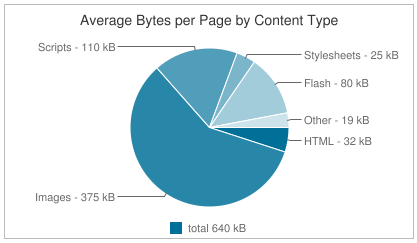HTTP Archive: web trends in nine months
Google expert Steve Souders (Steve Souders) has been supporting the HTTP Archive project for nine months, which periodically gathers technical information from about 17,000 of the largest Internet sites: content types, page size, use of various technologies, most popular scripts and JavaScript libraries , image formats, the number of pages with errors, etc.
The other day, Saunders summed up the results for the nine months from November 15, 2010 to August 15, 2011. The sample included only 13,000 sites for which data is available for both November 15 and August 15.
So, for nine months, the average size of web pages on the Internet has increased by 15% (95 KB) and now stands at 735 KB. This is the size of the transmitted data, whereas in uncompressed form the amount of content is greater. The main part of the growth was in the graphics (+ 18%, +66 KB) and scripts (+ 23%, +25 KB).
November 15, 2010:

')
August 15, 2011:

Interestingly, while the average size of individual resources on the page has not changed, that is, the graphics and scripts remained on average the same size as nine months ago. The increase in the amount of transmitted data is due to an increase in the number of elements and an increase in the number of HTTP requests. For nine months, the average number of HTTP requests to one page increased from 69 to 76 pieces.
Of the negative trends in the reporting period, an increase in the number of redirects can be noted: the number of sites with at least one redirect increased from 58% to 64%, the number of sites that gave an error to any request increased from 14% to 25%.
But there is also some good news: the use of the Google Libraries API has increased from 10% to 14%, so at least due to this, the entire web has, on average, started to work a little faster: after all, the Google servers themselves are faster than others, and the probability that when surfing on different sites, some resources will already be in the user's cache.
The use of Flash technology has dropped from 47% to 45%. This is also good for performance, because individual files with Flash content are significantly larger (an average of 58 KB) than individual files with any other kind of content. In addition, there are few ways to optimize Flash.
Progress is also noticeable in the number of resources that support caching: the share of resources supplied with the corresponding HTTP header has increased in nine months from 39% to 42%.
The other day, Saunders summed up the results for the nine months from November 15, 2010 to August 15, 2011. The sample included only 13,000 sites for which data is available for both November 15 and August 15.
So, for nine months, the average size of web pages on the Internet has increased by 15% (95 KB) and now stands at 735 KB. This is the size of the transmitted data, whereas in uncompressed form the amount of content is greater. The main part of the growth was in the graphics (+ 18%, +66 KB) and scripts (+ 23%, +25 KB).
November 15, 2010:

')
August 15, 2011:

Interestingly, while the average size of individual resources on the page has not changed, that is, the graphics and scripts remained on average the same size as nine months ago. The increase in the amount of transmitted data is due to an increase in the number of elements and an increase in the number of HTTP requests. For nine months, the average number of HTTP requests to one page increased from 69 to 76 pieces.
Of the negative trends in the reporting period, an increase in the number of redirects can be noted: the number of sites with at least one redirect increased from 58% to 64%, the number of sites that gave an error to any request increased from 14% to 25%.
But there is also some good news: the use of the Google Libraries API has increased from 10% to 14%, so at least due to this, the entire web has, on average, started to work a little faster: after all, the Google servers themselves are faster than others, and the probability that when surfing on different sites, some resources will already be in the user's cache.
The use of Flash technology has dropped from 47% to 45%. This is also good for performance, because individual files with Flash content are significantly larger (an average of 58 KB) than individual files with any other kind of content. In addition, there are few ways to optimize Flash.
Progress is also noticeable in the number of resources that support caching: the share of resources supplied with the corresponding HTTP header has increased in nine months from 39% to 42%.
Source: https://habr.com/ru/post/127210/
All Articles